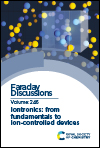Surface polarization enhances ionic transport and correlations in electrolyte solutions nanoconfined by conductors†
Abstract
Layered materials that perform mixed electron and ion transport are promising for energy harvesting, water desalination, and bioinspired functionalities. These functionalities depend on the interaction between ionic and electronic charges on the surface of materials. Here we investigate ion transport by an external electric field in an electrolyte solution confined in slit-like channels formed by two surfaces separated by distances that fit only a few water layers. We study different electrolyte solutions containing monovalent, divalent, and trivalent cations, and we consider walls made of non-polarizable surfaces and conductors. We show that considering the surface polarization of the confining surfaces can result in a significant increase in ionic conduction. The ionic conductivity is increased because the conductors’ screening of electrostatic interactions enhances ionic correlations, leading to faster collective transport within the slit. While important, the change in water’s dielectric constant in confinement is not enough to explain the enhancement of ion transport in polarizable slit-like channels.

- This article is part of the themed collection: Iontronics: from fundamentals to ion-controlled devices


 Please wait while we load your content...
Please wait while we load your content...